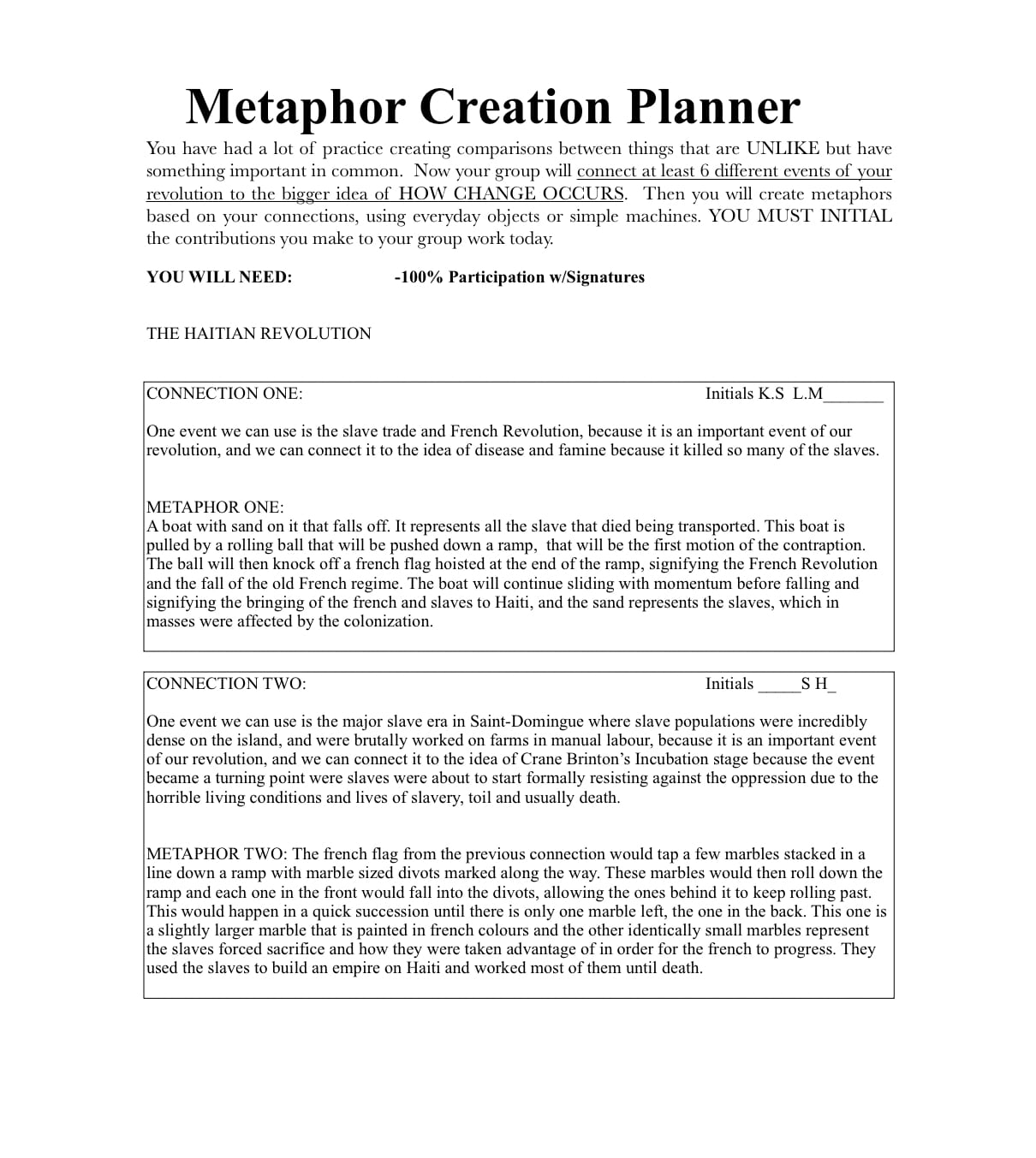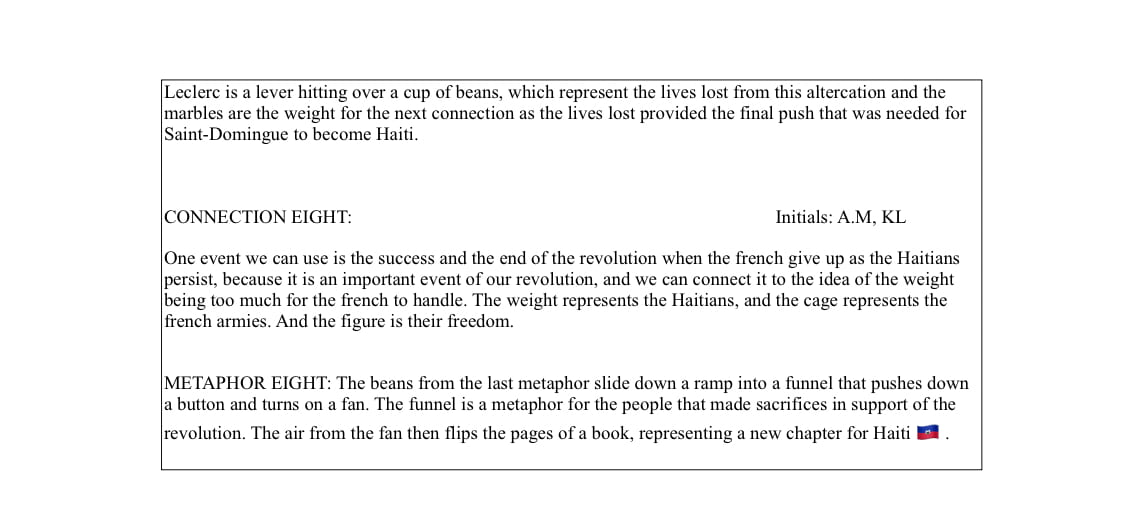How do ideas drive change?
This was the question the grade 9s attempted to answer at this years Winter Exhibition. We did this by learning about revolutions and creating metaphorical interpretations of specific revolutions, their impacts and their causes.
We had to understand what makes a revolution, well, a revolution, before building Rube Goldberg machines, or even learning about specific revolutions. To do this, we learned about Crane Brinton’s anatomy of revolution. Brinton’s theory suggests all revolutions share 4 common stages. The incubation stage, the moderate stage, the crisis stage, and the recovery stage. The incubation stage is a time of discontent and division within classes, disdain for weak rulers, half-hearted reform from rulers, economic crisis, intellectual opposition (intellectuals speaking out against the government), military victory, and a sense of government injustice. The moderate stage is made up of protests and small scale violence. The crisis stage is marked by radicals gaining control of government, mass violence occurs, regicide (assassination of monarch) can also take place, radicals form revolutionary councils, civil and foreign war may take place, and secret police are often mixed into this stage. Finally the recovery stage happens and radicals are removed from power. A regime reminiscent of the old one returns, slightly changed through impacts of the revolution. This stage is characterized by peace or war, sometimes both.
After understanding the stages of a revolution we took our learning further in reading Animal Farm, by George Orwell. If you are unfamiliar with the story, it is a metaphor for the Russian revolution. Animals on a farm overthrow their human counterparts in hopes of creating a more fair society, only to end up resembling the very humans that drove them to revolt. Reading this book doubled as an opportunity to better understand revolutions and to create effective metaphors simultaneously.
Now that we understood revolutions and how to create metaphors out of them we were put into groups to represent specific revolutions. We spent some time researching our revolutions and created infographics to show our understanding of our revolution and how it fits into Crane Brinton’s theory of a revolution. I was placed into the Haitian revolution group with Izzy, Baz, Quin, Kai, Lucas M, and Aiden.
At this point we had all the knowledge we needed to begin creating our Rube Goldberg machines!
As part of the planning for our Rube Goldberg Machine we created a document which contains all of the parts of the machine, the associated metaphors for each part, and the revolution event each metaphor depicts. This is that document:




Another important piece of the project was making a documentary which explained the machine building process. Unfortunately our documentary editor was sick during a crucial period of time and the documentary was definitely impacted by this, but we had to adapt, and we did.
The real issues began showing themselves the dreaded day of the exhibition. We made the significant mistake of trying to assemble our entire machine the day of. Now when I say assemble, I mean attach all the individual metaphors together, huge misstep. Initially we had planned to connect the pieces multiple days earlier to try and do a run-through, but that proved challenging as some of the building had not been completed by certain members of the group.
There were some major learnings from this experience. One of which was if a member of a group is unable to meet a deadline, that means all hands on deck from the rest of the team! The missing of a deadline calls for a conversation within the group about what went wrong, why it went wrong, and how we are going to move forward. We have to work together to support each other during our shorting comings, this is especially crucial within a group setting.
Anyways, I digress. So there we were, standing in front of an entirely dysfunctional machine, (slightly) losing our minds. Not that anyone could tell. (Everyone could tell). At least I know I was losing it a bit, I can’t speak for anyone else. After some frustration and a few deep breaths, we persevered and problem solved (somewhat).
Before continuing I feel that it is important to thank 2 people.
Monica, thank goodness for you and your absolute kindness in trying to help us problem solve in the midst of the chaos, you had no obligation to, yet you did. A true show of character.
Quin, thank you for working feverishly alongside me sacrificing your lunch and 4th period to try and wrangle together the functional pieces of our machine in an attempt to have something that remotely resembles a functioning Rube Goldberg machine. I admire your willingness and dedication.
With that out of the way, want to hear how the mess of a night unfolded? (Spoiler: You’re being told regardless).
After working with Monica and Quin for a few hours, we had managed to arrange the pieces of the machine in a way that theoretically could function. Unfortunately as we know theory doesn’t always align with practice. This was an example of that. At 3:00, when the rest of the team arrived, we put them to work, fan dangling, still attempting to produce a (somewhat) working machine. 5:00, the doors open, and guess what? No functional machine to be found. Not in the Haitian revolution anyway.
So the machine didn’t work, and it didn’t look good, did anything go well? I would say one thing we did do quite well was our presentation. Everyone spoke, everyone understood the material they were referencing, and we played off the machine not functioning pretty well. We told people to just pretend to be surprised when it didn’t work, or alternatively act as though it did. While the Rube Goldberg machine didn’t manage to function in the manner we expected, we had good bones in place, we understood our revolution and had sound metaphors, and I would argue that is the more important of the two.
Though we had our difficulties I am glad I got the opportunity to work with my team. And to anyone that might’ve seen our machine in action, it totally worked, right? (Just say yes).
Thank you for reading! Have a good rest of your day/night.
